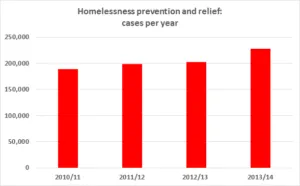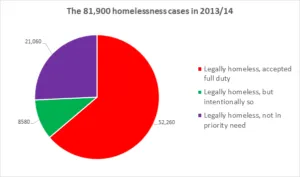Homelessness: the warning hidden in plain sight
Published: by Zorana Halpin
The pithily titled DCLG Homelessness Prevention and Relief statistics are out today. These annual statistics are rarely ever talked about. Just contrast today’s deafening silence with the buzz about the bedroom tax stats last week.
But their bureaucratic veneer masks important figures we need to be talking about.
Today’s statistics are different to the DCLG figures on statutory homelessness. The statutory homelessness figures look at households who have been through a legal assessment to determine whether they are homeless or not, who may then be found legally homeless.
The homelessness prevention and relief statistics count up actions taken by councils (such as negotiating with landlords who want to end tenancies or tackling bad conditions) to help people avoid losing their homes – which is known as ‘prevention. ’
They also cover action taken by councils to rehouse households who have lost their home (though not legally recognised as homeless) – this is known as providing ‘relief.’
The 200,000 plus cases of homelessness prevention and relief dealt with by councils last year are a warning sign hiding in plain sight, of the potential for tens of thousands more families to face homelessness and put already over-stretched councils under intolerable strain.
They highlight the failures in the housing system and strains in the welfare system.
They highlight the short-term, sticking plaster solutions and incentivisation schemes being used by councils desperate to stem the tide of homelessness.
In short, if you want to understand what’s happening on the front line of the housing crisis, you need to look at these figures.
So what do they show?
1. In 2013/14 councils had to take action in over 200,000 cases to help households avoid or relieve homelessness
Councils are seeing more cases than they have ever seen. Over the last 5 years there has been a massive 38% increase in people getting help.
2. They are a sharp reminder that the scale of homelessness is likely to be greater than statistics on the number of legally homeless households that DCLG produce every quarter.
In addition to the 81,900 households found to be formally homeless , today’s figures mention 18,500 cases of people being helped by councils who weren’t assessed under homeless legislation but had lost their home. These households could be a subset of the homelessness cases in the chart below or they could be additional. It’s hard to tell. And that’s not good enough.
3. They indicate that housing benefit changes are definitely taking their toll.
A whopping 24,400 of the cases seen by councils involved helping people with housing benefit-related issues. We already know from the government’s own statistics that 59% people are in rent arrears because of the bedroom tax. What these figures tell us is, unsurprisingly, benefit cuts are driving people to turn to their council for help in keeping their home or finding alternative affordable accommodation. The fact that housing benefit issues can no longer be covered by Legal Aid might explain why so many cases are coming through to local authorities.
4. Right now, the private rented sector is both part of the problem and part of the solution.
What these figures show is the dependency of the council on the private rented sector. In 3,500 cases, the council took action by putting people into the private rented sector, most likely on minimum six month contracts with no requirements to ensure the homes are suitable, as is the case with placements of homeless people in the PRS. Placing a household in the private rented sector sometimes involves ‘incentivising’ landlords through ‘golden handshake’ type arrangement – such as paying £2,000 ‘finder’s fees.’ This is all in the context of the end of private rented tenancies being the leading cause of homelessness.
4. The burden of housing and homelessness problems is firmly on local councils.
Local authorities are bearing the burden of a housing benefit system and private rented sector that is creaking at the sides.
They are seeing more people than ever come to their doors. And all in the context of shrinking budgets.
We are concerned that local council practice will increasingly start to suffer. I wrote earlier in the year that if this continues councils will struggle to cope to provide vital homelessness services.
Recent reports suggest this is coming to fruition and that the true scale of homelessness could be even greater.

